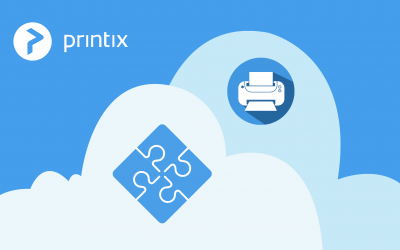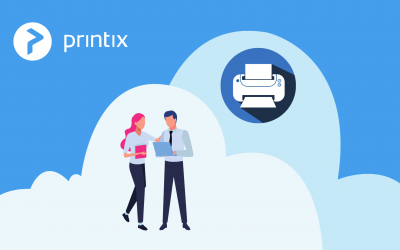The past, present and future of Cloud Print Management
Digital disruption is all around us. Every industry has been touched by the need to maintain a competitive edge by transforming processes using technology. The print industry is no exception. In a recent podcast, Louella Fernandes, Director of Quocirca talked to our own, Hugo Marqvorsen, Co-founder, and Sales Director of Printix, about how the print industry is stepping up to meet the needs of digital disruption.
Printix is creating a print environment for the modern workplace
Hugo Marqvorsen has a long history of working in technological innovation. He called upon his vast experience in the print industry and cloud printing when he helped to co-found Printix back in 2014. Hugo Marqvorsen discussed the foundation of Printix and how the solution design came out of a practical need for a new way to manage print. Read on for some insights into where we have been, where we are now, and where we are likely to go in the print industry.
Printix cracks Denmark
Hugo Marqvorsen gave Louella Fernandes a glimpse of digital life in Denmark. Denmark is a digital innovator: for example, the mortgage process in Denmark is now fully digitized, there are no paper processes in conveyancing. This has been largely due to a Danish government digital signature initiative back in 2010, whereby all Danish citizens were given a digital signature. This had a dramatic impact on how Danish businesses operate. The Danish postal service, for example, has seen a 95% drop in its printing and mail delivery over the last 10 years.
“The number of A-class letters has decreased by 82 percent since 1999 and today the average Danish household sends fewer than four A-letters per year” – The Local, Denmark
Because Denmark leads the way in digital transformation, many organizations have digitized their work processes, converting them from paper-based to digital; the result has been a large reduction in local printing. At the time that Printix was starting up, we were working as a consultant for a government ministry in Denmark; this offered an insider view of the print behaviour of the organization. We realized during that analysis that the print, copy, and scan/capture events were reduced dramatically when they went to the cloud.
This was an ‘Aha!’ moment for the nascent Printix as it demonstrated a key trend in print behaviour. We took a risk: if the ministry is moving in this direction, then other companies will be too. We realized that those companies would need an effective print solution that worked in a cloud environment – this was the start of Printix.
Printix becomes a reality: Simplify and Automate
The experience in the ministry gave the founders of Printix the intelligence needed to design a solution. Out of this came five key design remits, underpinned by the mantra of Printix that remains in the solution today, to simplify and automate: The five key design remits of Printix, the solution, and the company, became and remain:
- Work with what is out there
Printix was designed from the outset to work with the most popular platforms, including Microsoft Azure. With over 284,000 companies worldwide using MS Azure this ensured that Printix would be able to approach a large market base.
- Create tight integrations
The fundamental design remit of the Printix solution was to be fully cloud-enabled and tightly integrated with both Microsoft and Google. This meant that the solution also had to ensure tight integration with Microsoft components including Endpoint Manager and Microsoft tools including Power BI.
- Seamless authentication
Cloud-based user authentication is another crucial part of Printix. Having integration with existing identity management systems such as Azure Active Directory, Google Workspace, Okta and OneLogin is a key part of the usability of Printix to this day.
- Cloud printing but support local
Optimization of the end-user experience meant that when printing via the cloud was not needed, Printix would support local printing.
- Create strategic partnerships
By designing for Microsoft Azure, Printix was also able to leverage a close Microsoft relationship.
Taking Printix and cloud-printing to the world
Back in 2014, cloud printing was still emerging. The print channel often did not have the underlying knowledge to convey the Printix message. However, the Managed Service industry did understand, and they became the catalyst channel for the Printix solution. Managed Service Providers (MSPs) were on the front line of moving customers from on-premise and hybrid into a cloud environment; MSPs [and Cloud Solution Providers (CSPs)] also had vast experience with Microsoft and its products.
Through the MSP channel, we had found our route to market, however, a new challenge appeared – how to price the product. Microsoft was selling their products on a ‘per user basis’. In the print industry, the product was sold on a ‘per device basis’. To fit the model, we had to deliver our service as an ‘active per user/per month’.
At Printix we adjusted our model to fit the MSP model, resulting in a product that was easy to deliver, and a business model that adhered to a per-user instead of a per-device pricing structure. This pricing model resulted in modifications to the product to increase simplicity and ease of use. The 80/20 rule informed development: 80% of customers use 5-10% of the features. Printix focused on this 5-10% to improve overall efficiency. The result was a product that was perfect for the MSP as it offered:
- Efficient delivery
- Was easy to understand for both MSP and customer
- Reduced support overhead
- And, could be delivered as a bundle to customers
Bridging the channels
The MSP channel and the print channel overlap, has been a challenge for Printix.
“…the MSP channel, perhaps don’t understand print, and the MPS (Managed Print Services) channel, understand print but do not understand cloud.”- Marqvorsen told Fernandes
Squaring this round took time and Printix found ways to bridge the gap. The key component in Printix is a cloud component, a piece of software that is installed on every client’s computer. Managed Service Providers are perfect partners for this. Using tools such as Microsoft Endpoint Manager, MSPs can ensure that the Printix client is installed seamlessly.
However, the print element of deployment is not typically in an MSP remit. They tend to not know about print drivers, how to configure printers, etc. But Managed Print Services (MPS) have this deep print knowledge. A synergistic offering that leverages the skills of MSPs and MPSs offers lucrative opportunities in cloud-print management services. MPS +MSP = the perfect cloud print management pairing
Cloud print management now and in the future
Hugo Marqvorsen discussed his vision for the near future market for cloud printing: “one of the things we learned, moving forward is a change in how companies look at implementing infrastructure that is future-proofed.”
When Printix first started up, security was less of an issue than it is now. Remote working back then was also less of an issue. Printix now sees a focus on a Zero Trust network infrastructure where each client is separated from the other and only communicates with the cloud. Remote offices have added a new layer of security challenges.
It’s important that even in the remote office, productivity remains high. The remote office must support work local, print local, but have access to the cloud. This design paradigm has informed the architecture of the Printix solution – ensuring that flexible working can have flexible printing.
Marqvorsen pointed out that even as the pandemic recedes and remote working changes to a more flexible hybrid working model, remote printing will still be needed. Companies continue to future-proof their offices, including those that are remote.
How the Covid-19 pandemic ushered Printix into home office printing
At the outset of the COVID pandemic, Printix was contacted by an Australian bank. The bank had 12,500 employees suddenly working from home. Coupled with this, 2,500 employees required highly secure printing as they worked with legal documents. The bank was set up so that an employee could not automatically add a home office printer to the print environment. To support this need for secure home printing, Printix developed our “home office printing” feature.
Printix home office printing solution
The Printix solution can automatically discover local printers at home and automatically add a print driver for the home office printer. At the same time, Printix monitors what the individual is printing, how much they are printing, when they are printing, etc. Printix remote cloud printing solution supports IPPS printing, so you can print securely from the client computer to the local office. Printing via IPPS ensures that print traffic to the printer is encrypted. Since then, Printix has also recognized the need to handle other complex print scenarios.
Another feature to come out of the pandemic is the ability to automatically add a print environment based on where an employee is – this is based on the changed commute environment between a home office and the corporate office. This ‘print on the go’ feature allows employees to move around and wherever they are there is a relevant print environment with robust authentication, etc. All the while, the print audit continues.
A Printix secure future
Printix continues to expand its reach using a variety of channels. The company recently launched its first distribution with global distributor SYNNEX, in the US and Australia. Because companies such as this distribute Microsoft licenses, it’s easy to bundle the Printix service with other types of licenses. Printix expects this model to be a natural part of the future delivery of the solution.
One of the Printix features, ‘Printix Go’ can be bundled alongside a traditional Pull Print/Secure Print option to offer the best of both worlds. The ease of deployment and ease of use makes Printix a perfect choice for all sizes of organizations. One example is the Norwegian company, Jotun, which moved 8,000 employees and converted 250 offices to cloud printing in only took two weeks.
A final word from Hugo Marqvorsen
Hugo Marqvorsen concluded the conversation with Louella Fernandes by saying: “The modern enterprise operates across a much more complex print environment, being multi-vendor, and so on. Printix has seen such rapid adoption of cloud over the past year, due to the pandemic, and I think that’s a huge opportunity for the print market.”
He continued: “Before the pandemic, on average, 74% of all users were printing regularly. During the pandemic, this figure dropped drastically. Now we see it ramping up again. Now, however, there is a cloud-first expectation. Organizations are also looking at how to optimize workflows, and how to remove paper from a workflow.
The print industry is changing. And I don’t think we will enter at the same level as before. This includes the purchase of new printers, companies wanting to “wait and see” what the impact of a cloud transformation brings and what the future printing need is, for example, how many users per device are needed?
Five years ago, Printix had about 15 users per device in an enterprise setting, now we see 25 users, on average, per device. I expect that number to continue to increase. I see a trend for the volume of devices to go down with the volume in printing also decreasing, as customers are transforming to cloud; however, what is a constant is that users still need to print.”
Printix can be found on the Azure Marketplace or here>>
In the Spotlight with Printix Cloud-native printing for the modern workplace.
About Quocirca
Quocirca is a primary research and analysis company specialising in the business impact of information technology and communications (ITC). With worldwide, native language reach, Quocirca provides in-depth insights into the views of buyers and influencers in large, mid-sized and small organisations.
Its analyst team is made up of real-world practitioners with first-hand experience of ITC delivery who continuously research and track the industry and its real usage in the markets.
Louella Fernandes – Research Director at Quocirca
Louella Fernandes is globally recognised as a leading authority on market trends in the print, imaging and managed services industry. With 25 years of experience in the sector, she provides an unparalleled insight into the evolution of print in the digital age and is a highly respected authority on digital disruption in the print industry. A valued source of market intelligence and strategic insight for print manufacturers, channel partners and ISVs, Louella’s expertise is widely sought on issues concerning the future of the print hardware, software and managed services sector.
Watch the full interview here>>




